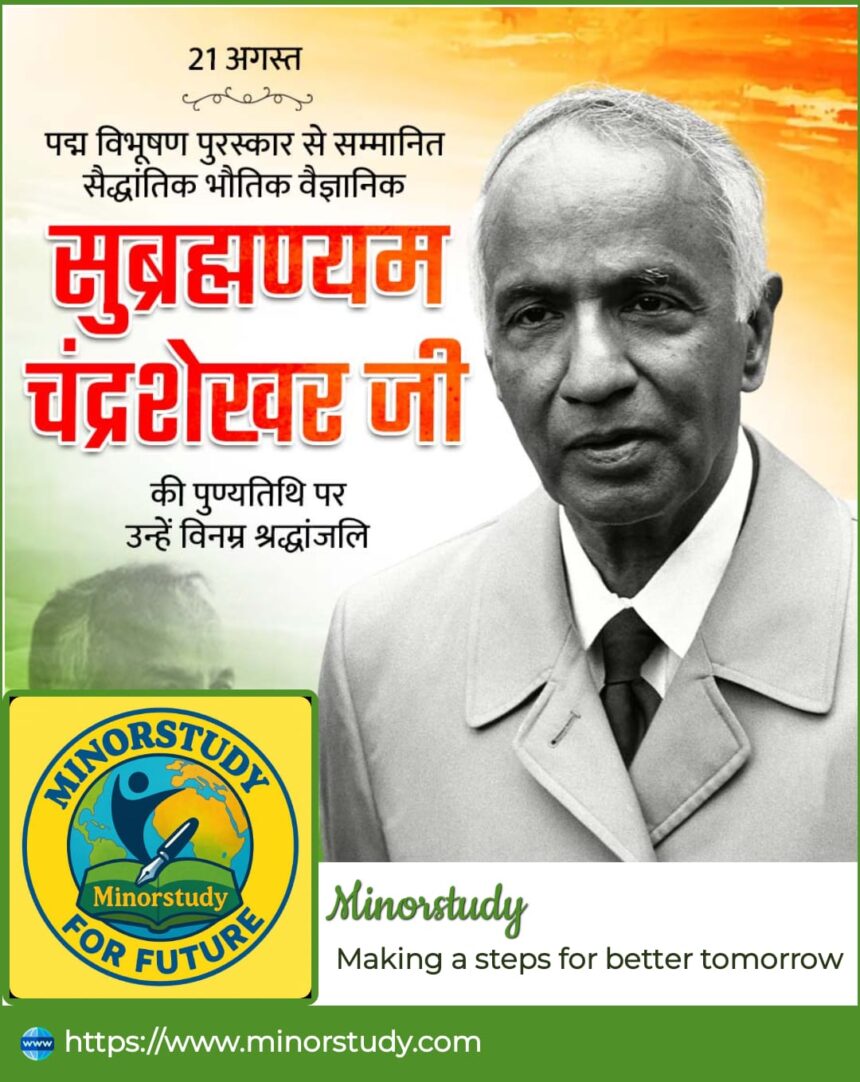Inspiring Facts About Subrahmanyam Chandrasekhar Ji: The Brilliant Mind Who Changed Science Forever
Introduction
In the history of science, very few personalities have left an everlasting mark on how we understand the universe. Subrahmanyam Chandrasekhar Ji, widely known as Chandra, was one such extraordinary astrophysicist. His remarkable theories about the structure and evolution of stars not only earned him the 1983 Nobel Prize in Physics, but also changed the course of modern astrophysics.
- Introduction
- 🏛️ History of Subrahmanyam Chandrasekhar Ji
- 📜 Timeline of His Life & Achievements
- 🌌 Facts About Subrahmanyam Chandrasekhar Ji
- 🌍 Significance of His Contributions
- 🎉 Wishing & Remembering Chandrasekhar Ji
- 🙏 Importance in Our Life & Society
- 📖 FAQs About Subrahmanyam Chandrasekhar Ji
- 🌟 Important Points at a Glance
- 💡 Daily Life Impacts
- 🏆 Conclusion
Born in 1910 in Lahore (then British India, now Pakistan), Chandrasekhar went on to become one of the most influential scientists in the world. His work on the Chandrasekhar Limit, which defines the maximum mass a white dwarf star can have before collapsing into a neutron star or black hole, remains a cornerstone in astronomy.
This article takes you through his history, facts, timeline, significance, FAQs, and daily life impacts, all written in a human-friendly style to celebrate his life and legacy.
🏛️ History of Subrahmanyam Chandrasekhar Ji
Birth: October 19, 1910, Lahore (British India).
Parents: Belonged to a Tamil-speaking family; his father was a civil servant, and his mother was deeply interested in literature.
Education: He studied physics at Presidency College, Madras, and later pursued higher studies at the University of Cambridge, England.
Early Research: At just 19, while traveling by ship to England, he began calculating what would later become the Chandrasekhar Limit.
Career: He later became a professor at the University of Chicago, where he worked for several decades.
Nobel Prize: In 1983, he shared the Nobel Prize in Physics with William Fowler for his work on the physical processes of stars.
Death: Passed away on August 21, 1995, in Chicago, USA.
📜 Timeline of His Life & Achievements
1910 – Born in Lahore.
1925 – At age 15, began showing a keen interest in physics.
1930 – Went to Cambridge for higher studies.
1931 – Formulated the Chandrasekhar Limit.
1935 – Faced opposition from Sir Arthur Eddington but stood firm on his theory.
1937 – Joined the University of Chicago.
1953 – Became a U.S. citizen.
1960s–70s – Wrote several influential books on stellar dynamics and black holes.
1983 – Awarded the Nobel Prize in Physics.
1995 – Left the world, leaving behind an eternal scientific legacy.
🌌 Facts About Subrahmanyam Chandrasekhar Ji
He was the nephew of C.V. Raman, another Nobel laureate from India.
At just 19, he calculated the Chandrasekhar Limit, which revolutionized astrophysics.
Despite early opposition from prominent scientists, his work later became universally accepted.
His research covered stellar evolution, relativity, black holes, and fluid dynamics.
He wrote many authoritative books, such as “The Mathematical Theory of Black Holes.”
He was deeply humble and never sought publicity for his work.
The NASA Chandra X-ray Observatory, launched in 1999, is named in his honor.
He believed in combining art, mathematics, and science as interconnected fields.
He guided several Ph.D. students who later became prominent scientists.
He balanced his scientific genius with a deep love for literature and music.
🌍 Significance of His Contributions
The importance of Subrahmanyam Chandrasekhar Ji’s work can be felt even today:
Scientific Breakthroughs: His theories explain how stars live, evolve, and die.
Foundation for Black Hole Studies: Without his limit, the study of black holes may not have developed so profoundly.
Inspiration for Generations: He showed how determination and belief in truth can overcome criticism.
National Pride: He remains one of the brightest Indian-origin scientists to have earned international recognition.
🎉 Wishing & Remembering Chandrasekhar Ji
On his birth anniversary (October 19) and death anniversary (August 21), scientists, students, and admirers across the world honor his memory.
A wishful message could be:
“May the brilliance of Subrahmanyam Chandrasekhar Ji continue to inspire every student of science to reach beyond the stars. His journey reminds us that truth in knowledge always shines bright, even in the darkest night of doubts.”
🙏 Importance in Our Life & Society
For Students: He inspires the youth to pursue science fearlessly.
For Teachers: His life is an example of patience and perseverance in academia.
For Society: His contributions to astrophysics make us understand our universe better.
For India: He is a symbol of intellectual excellence and global recognition.
📖 FAQs About Subrahmanyam Chandrasekhar Ji
Q1: What is the Chandrasekhar Limit?
👉 It is the maximum mass (about 1.4 times the mass of the Sun) a white dwarf star can have before collapsing into a neutron star or black hole.
Q2: Who was Subrahmanyam Chandrasekhar’s famous uncle?
👉 He was the nephew of Nobel Laureate C.V. Raman.
Q3: When did Chandrasekhar win the Nobel Prize?
👉 In 1983, for his stellar structure and evolution theories.
Q4: Why is NASA’s Chandra X-ray Observatory named after him?
👉 To honor his outstanding contributions to astrophysics and his role in explaining high-energy cosmic phenomena.
Q5: What was his biggest struggle in science?
👉 Facing public criticism from Sir Arthur Eddington, a leading astrophysicist, who opposed his limit initially.
🌟 Important Points at a Glance
Born in 1910, Lahore.
Nephew of C.V. Raman.
Discovered Chandrasekhar Limit.
Faced criticism but stood firm.
Nobel Laureate in 1983.
NASA’s Chandra Observatory named in his honor.
💡 Daily Life Impacts
While his work may sound far from daily life, in reality:
His research deepens our understanding of the universe we live in.
It inspires educational reforms in physics and astronomy.
His perseverance teaches us about resilience in personal and professional struggles.
His life encourages curiosity, questioning, and critical thinking.
🏆 Conclusion
Subrahmanyam Chandrasekhar Ji was not just a scientist but also a visionary who believed in the power of truth, perseverance, and intellectual honesty. His journey—from a young boy in India to a Nobel Prize-winning astrophysicist—shows us the true meaning of dedication.
In a society where success is often measured by quick results, his life reminds us that real breakthroughs take time, courage, and resilience. The Chandrasekhar Limit remains his immortal contribution, guiding astronomers and physicists for centuries to come.
✨ Final Thought:
“Chandrasekhar Ji’s brilliance reminds us that even when faced with resistance, truth in knowledge always wins. His legacy is not just written in books but is shining among the stars themselves.”








